Top News
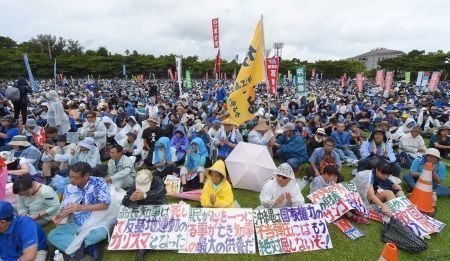
August 11, 2018 Ryukyu Shimpo Digital Edition
The “August 11 Okinawa convention to forbid land filling, and to demand protection for Dugong and coral and for the cancellation of new base facilities in Henoko,” (hosted by the All Okinawa committee to prevent new base construction at Henoko), which, as the name suggests, aims to stop land filling activity in Henoko Bay as part of the relocation of MCAS Futenma, opened the morning of August 11 at Onoyama Park in Naha.
The hosts announced that around 70,000 people attended.
The event, which aimed to bring together 30,000 people, took on additional meaning with the sudden passing of Okinawa governor Takeshi Onaga August 8, and when the event grounds opened at 10:00 a.m., a mass of people came in one after the other.
Participants carried signs with messages such as, “Okinawans will not give up,” showing their support for Governor Onaga’s revocation of approval for the land filling.
At the event, in response to the notification given by the Okinawa Defense Bureau (ODB) to Okinawa Prefecture stating that land filling at the tip of Henoko will start August 17, a resolution was adopted demanding the cancellation of the construction plan, stating, “Trampling over the will of the Okinawan people, the illegal construction that will lead to environmental damage continues by force.”
The participants donned both blue colors symbolizing the sea and air of Henoko, as well as black arm bands and ribbons to mourn the loss of governor Onaga.
There was a minute of silence observed, and a confirmation of Okinawa’s intent to continue Governor Onaga’s fight to stop new base construction, a campaign promise Onaga pursued right up until the very end.
Governor Onaga’s son and Naha City councilor Yuji Onaga spoke at the event, sharing a number of things the governor said throughout his life including, “Okinawa is a series of trials and tribulations. However, we have continued to fight without ever throwing away our pride as Uchinanchu. When Uchinanchu fight with one heart, it becomes something more powerful than you can imagine.”
He then made a plea to the crowd, saying, “Everyone, let’s do everything we can so that we can report to Takeshi Onaga that we were able to stop the new base construction at Henoko.”
Vice-governor Kiichiro Jahana, who attended as the representative from the Okinawa gubernatorial office, touched on Governor Onaga’s unrelenting resolve to revoke approval for land filling even while in the hospital, stressing, “It was his great regret that he fell to illness before his work could be finished, right at the time when the battle was beginning to heat up.
Having heard his wishes, I will continue to put all my energy into stopping the construction.
” Furthermore, regarding the revocation, Jahana resolved, “A hearing is being coordinated. Understanding the governor’s passion for stopping the construction at Henoko as part of being entrusted by all of us to run the prefectural government, I have decided to stand firm and continue his work.”
Naha mayor Mikiko Shiroma, shared with the crowd that she was in the same class in High School as Governor Onaga, continuing, “He told me about all of the strong feelings he had for his Okinawa. His feelings for Okinawa never wavered. He lived with the Uchinanchu heart held close, and acted as if he were the embodiment of the Uchinanchu heart. Unfortunately he could not see this through to the end, but all of us have been entrusted with carrying on for him.”
She added, “I think it is unfortunate that just as he was reaching the finish line of the revocation, he was unable to cross the finish line. I would like for all of us to continue his work in whatever way we can.”
On the stage, a seat for Governor Onaga was prepared, and on it was placed the blue hat he was planning on wearing at the event. The protest resolution, which gives a boost to Okinawa’s revocation, also stated, “We will continue to fight this absurdity for the sake of the lives and livelihoods of Okinawans, the autonomy of Okinawa, Japanese democracy, and peace.”
(English translation by T&CT and Sam Grieb)
Go to Japanese

August 11, 2018 Ryukyu Shimpo online edition
On August 11 at East Ikebukuro Central Park in Tokyo, an Okinawan prefectural rally met to show solidarity against land reclamation and base construction in Henoko, Nago City.
Those gathered mourned Governor Takeshi Onaga’s death and collectively showed their opposition to soil deposits into the ocean, set to start on August 17 as part of Henoko base construction.
According to the organizers, about 2,800 people participated. Attendees held up placards with mottos such as, “Let’s carry through Onaga’s dying wish,” and demonstrated in front of Ikebukuro Station. The participants called for solidarity against the Henoko base from the demonstration route.
Aside from the gathering in Tokyo, there were reports of more than 20 related rallies in other areas throughout Japan, including in Obihiro (Hokkaido), Tohoku, Chubu, Tokai, Kansai, and Fukuoka, all showing solidarity with Okinawa.
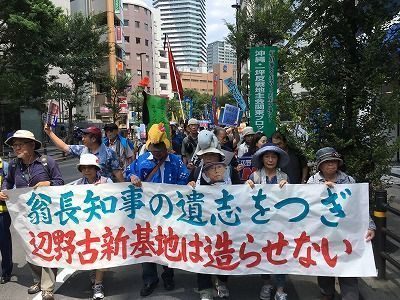
In Ikebukuro, Tokyo, on the afternoon of August 11, rally participants demonstrate in the streets in solidarity with the prefectural rally in Okinawa. Demonstrators carry on Governor Takeshi Onaga’s dying wish, and voice their opposition to construction of the Henoko base.
Shinichi Hanawa, a representative of the Okinawa Environmental Network, delivered a greeting at the Tokyo rally. He said, “I earnestly call for the deputy executing the governor’s duties to immediately revoke land reclamation approval, and block the soil deposits starting on the 17th. I want us to shoulder as our personal problems the certain opposition to new base construction, and in solidarity with citizens from across Japan, bring new base construction to a halt.”
At the start of the rally, participants offered silent prayers for Governor Onaga. Deputy Governor Kiichiro Jahana, who is executing the governor’s duties, delivered a greeting at the rally, which was met with applause.
Demonstrators on the route called out slogans like: “We cannot tolerate discrimination against Okinawa,” “It is also a problem for those of us who live in Tokyo,” “Stop construction,” “Protect the coral,” and “Don’t fill the ocean in Henoko with sand.”
On the route, there were passers-by who chanted along with the demonstrators’ calls, and people who took pamphlets opposing the Henoko base.
(English translation by T&CT and Erin Jones)
Go to japanese
August 9, 2018 Ryukyu Shimpo
Governor Takeshi Onaga, who had been battling progressing pancreatic cancer, died on August 8.
He was 67 years old.
Onaga underwent surgery in April earlier this year, but the cancer cells spread to his liver.
From the bottom of our hearts, we would like to offer our deepest sympathies.
Onaga campaigned on stopping the new base facility construction in Henoko Bay, Nago, and he was elected governor in 2014 with over 360,000 votes.
He was the seventh governor of Okinawa since its reversion to Japan.
From the moment he took office, Onaga gave all-out opposition to the central Japanese government’s imposition of new base construction.
We can only imagine that the grief and stress from all this and more accumulated over the years.
Onaga withdrew his predecessor’s approval of land-filling in Henoko Bay, which he had just announced July 27.
One can imagine that he faced the press corps to do this while suppressing the pain of cancer. As the title states, Onaga gave his life to fulfill his duties as a politician.
From the outset, the office of governor in Okinawa faces immense pressure almost incomparable to any other prefecture in Japan.
This is due to the fact that the island chain, which accounts for no more that 0.6% of Japan’s total landmass, yet contains 70% of all the land designated for U.S. military facilities, and from repeated, serious incidents such heinous crimes committed by U.S. military members and military vehicle crashes and other incidents.
Historically, each of Okinawa’s governors struggled with the grave over-burdening of bases on the islands.
That weight is severe enough to eat away at one’s health.
Koichi Taira, who succeeded Chobyo Yara after the prefectural reformation, spent most of his time in office working through the piled up governmental work now under prefectural control, and fell to cerebral thrombosis while in Tokyo on business in July, 1978.
After a stay in the hospital, Taira would retire in October of the same year.
The third governor, Junji Nishime, also underwent surgery for stomach cancer at a hospital in Tokyo in 1984.
At the time it was announced as a stomach ulcer and gall bladder infection, and even the governor himself was unaware of the fact that it was actually stomach cancer.
The fourth governor, Masahide Ota, exited a February prefectural assembly opening in 1992 with cold-like symptoms and dizziness, and entered the hospital. He would return to office 51 days later.
The fifth governor, Keiichi Inamine, was never admitted to the hospital while in office, however the base issue was always at the forefront of his mind, and he talks about how each day it was an incredible psychological pressure.
The sixth governor, Hirokazu Nakaima, was hospitalized with a light brain infarction shortly after the Okinawa Memorial Day ceremony June 23, 2007.
Onaga was a governor who devoted all of his energy to the base issue. Every chance he had he would continue to state, “We will not allow a new base to be constructed at Henoko.”
To be struck down by illness before it could be completed must have been a regret.
Vice-governor Kiichiro Jahana will take on the acting governor role before handing the reigns over to co-vice-governor Moritake Tominaga.
A hearing to ask the Okinawa Defense Bureau (ODB) about the revocation of the approval to fill land in Henoko planned for August 9 will be rescheduled.
First, they are going to take appropriate measures to ensure the prefectural government operations continue to run smoothly, which includes their strategy for handling the base issue.
Following the death of the current governor, the next gubernatorial election will take place within 50 days of the electoral notification being sent out.
Already, the Liberal Democratic Party (LDP), the opposition party in the Okinawan government, have tapped Ginowan Mayor Atsushi Sakima as their candidate.
The selection process for the ruling party candidate to succeed Onaga is well underway.
However the electoral showdown materializes, the upcoming electoral battle will hopefully develop into a head-on showdown over the base issue.
(English translation by T&CT and Sam Grieb)
Go to Japanese

August 9, 2018 Ryukyu Shimpo
After the death of Okinawa Prefectural Governor Takeshi Onaga, who opposed the construction of the new base, on the morning of August 9 more than 200 people gathered in front of the U.S. military’s Camp Schwab in Henoko, Nago City to mourn Onaga’s death.
People were saying things like, “Governor Onaga did not waver until shortly before death; he was a real politician.” Some of those present wiped away tears.
Approximately 40 citizens gathered from 8:00 a.m. and offered silent prayers for the governor at the space between the fence set up on the sidewalk and the road.
Remembering Onaga’s political attitude, people shared thoughts such as, “Now is the time to unite and pass down Governor Onaga’s intentions.”
Throughout the morning, no construction vehicles hauled in any materials.

Citizens sharing their feelings for Governor Onaga with onlookers
Citizens marched while calling out, “Stop the construction of the new base,” and “Thank you, Governor Onaga.”
Many citizens thronged to the front of the gate.
People who could not enter the crowded tents sat at the bases of trees and on the grass.
Others stood and stared at the gathering. Each person cared deeply about Governor Onaga.
Citizens who came from all over the prefecture by bus held microphones and shared their feelings.
A woman who visited from Okinawa City said, “We talked [in the bus] about taking the Governor’s intentions and working harder [to stop new base construction].”
In the tents where the temperature rose with the strong sunlight, many citizens gazed at the speakers, nodding and applauding.
Some people read in the newspaper about Governor Onaga, his life, and the people closest to him.
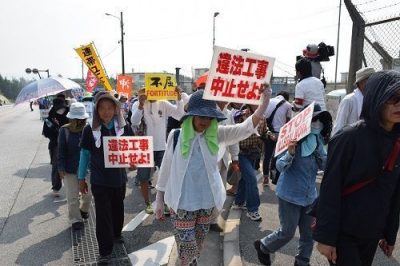
Citizens marching and calling, “Stop illegal construction!”
At 11:02 a.m., the time when the atomic bomb was dropped on Nagasaki, people offered silent prayers in the tent.
(English translation by T&CT and Megumi Chibana)
Go to Japanese
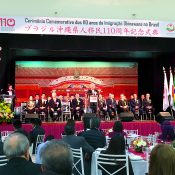
August 6, 2018 Ryukyu Shimpo
On August 5, the 110th anniversary ceremony for Okinawan immigration to Brazil was held at the Okinawa Cultural Center in Diadema, Brazil. Okinawa Vice Governor Moritake Tomikawa and others from Okinawa attended the ceremony.
Participants told the history of hardship endured by the first immigrants who traveled to Brazil via the Kasato Maru in 1908.
Participants also reaffirmed their desire to deepen the ties among Uchinanchu.
There was a memorial service and a celebratory parade to reminisce the achievements of the Okinawan predecessors.
In addition, there was a ceremony where letters of appreciation were presented to the elders of Okinawan descent.
The 110th anniversary ceremony for immigration was also held in Argentina on August 8 and in Bolivia on August 12.
According to a representative of the Okinawa Prefecture, Vice Governor Tomikawa relayed a message from Governor Takeshi Onaga during the ceremony.
He said, “Okinawans are very proud of the activities of the Okinawan descendants in Brazil. We look forward to seeing Okinawan descendants taking part in more activities by using this 110th anniversary as an opportunity to pass on the Okinawan culture to the next generation. We also hope that they establish a network that goes beyond generations or areas.”
During the awards ceremony that was held at the Legislative Assembly of Sao Paulo on August 3, letters of appreciation from Okinawa Prefecture were presented to peoples of merit who strove to develop a society for Okinawan descendants and cultural exchange between Okinawa and Brazil.
People who are 90 years old or above were also given awards.
Isao Yamashiro, who held the positions as the president of the Okinawan Association and the chairman of the Okinawan Cultural Center in succession, represented the Okinawan descendant awardees and gave a speech.
Okinawan Association Brazil President Eiki Shimabukuro said, “The current society for those of Okinawan descent is supported by the teachings of predecessors, philanthropy, spirit of mutual aid, and the hearts of Uchinanchu who cherish our ancestors and culture.”
On August 4, there was a pre-event parade where many people of Okinawan descent participated dressed in Ryuso (traditional Okinawan attire).
The 16th Vila Carrao Okinawa Festival was also held in the Vila Carrao District of Sao Paulo.
Besides people of Okinawan descent, many local people also attended. In the afternoon on August 5 (August 6 in Japan), a celebratory festival was also held.
(English translation by T&CT and Chelsea Ashimine)
Go to Japanese
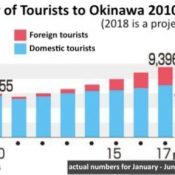
August 10, 2018 Ryukyu Shimpo
On August 9, the Nansei-shoto Industrial Advancement Center (NIAC) compiled its analytical results of the causes of fluctuations in numbers of tourists to Okinawa.
The NIAC used a seasonal adjustment method to remove seasonal fluctuations and find the “real number” of tourists to Okinawa.
It analyzed the irregular variations in short-term trends and cyclical variations in mid-to-long-term trends.
These analyses project that there will be 6,920,000 domestic visitors in 2018, and 3,440,000 foreign visitors, reaching a total of 10,360,000 tourists.
This would surpass the prefectural goal of 10,000,000 tourists for 2018.
Foreign tourism seems likely to exceed the goal of 3,000,000 people.
However, the growth in domestic tourism has slowed down, so it is likely it will not reach the goal of 7,000,000 tourists.
The NIAC analyzed statistics about numbers of tourists to Okinawa between January 1995 and June 2018, using seasonally adjusted values.
Compared with the May last year, the real number of domestic tourists to Okinawa this year was less.
These analyses showed that the trend fluctuations known as cyclical variations had decreased over two months starting in March 2018.
Looking at the coefficient of variation (CV) regarding seasonal fluctuations as removed by the seasonal adjustment method, it is clear the latter half of the 1990s had large differences in tourism during peak seasons versus off periods.
The 1995 peak season and off period had a large difference with a CV of 17.1, but in 2005 the difference between these periods was much less a CV of 10.09. However, thereafter these CVs have remained steady, and the NIAC is facing the challenge of equalizing seasonal fluctuations.
Looking at cyclical variations in foreign tourism trends, when the yen appreciates, the growth in numbers of tourists to Okinawa slows down.
The NIAC has analyzed that the appreciation of the yen affects tourism.
The projection found by the seasonal adjustment method closely reflects the latest data, though it seems likely that it somewhat overestimated the number of foreign tourists.
(English translation by T&CT and Erin Jones)
Go to Japanese
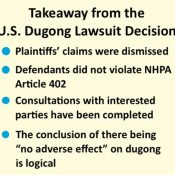
August 4, 2018 Ryukyu Shimpo
Washington Special Correspondent Yukiyo Zaha reporting
On August 1 the San Francisco District Court dismissed an appeal of the dugong lawsuit brought against the United States by U.S. and Japanese environmental conservation groups for the purpose of protecting endangered dugongs. The plaintiffs requested that construction of the Futenma Replacement Facility (FRF) in Henoko, Nago City, be stopped.
This trial addressed the effects of construction on dugong, and whether or not the “taking into account” (TIA) process was fulfilled. The TIA process refers to Section 402 of the U.S. National Historic Preservation Act (NHPA), which when applied to these circumstances holds that the U.S. Department of Defense (DoD) shall “take into account” the potential adverse effects on a property on the Okinawa dugong, including consultations with local interested parties.
Judge Edward Chen decided that the biological assessment and cultural assessment entrusted to the DoD, based in the Japanese government’s environmental impact assessments, mean that the defendants adequately took the effects of construction on dugong into account. He found that the U.S. government’s conclusion of there being “no adverse effect” on the dugong was not arbitrary or capricious.
However, regarding the discussion procedures Judge Chen ruled that, “While Defendants’ outreach could and perhaps should have been broader to individuals, inter alia, Plaintiffs, the Court cannot say Defendants violated to procedural requirements of Section 402.”
This lawsuit was initiated in 2003, and its substantive and public hearing was concluded on June 28 this year. The plaintiffs will decide whether or not to do an appeal to higher within the next 60 days. Governor of Okinawa Takeshi Onaga has decided to start the process toward revoking the land reclamation approval allowing such work on the shore portion of Henoko to build the Futenma Replacement Facility. On August 9 there will be a hearing for the Okinawa Prefectural Government to listen to the Okinawa Defense Bureau’s explanation, which may affect future court decisions.
This is the first time, historically, that a case has been brought to court regarding Section 402 of NHPA, which applies to sites outside of the United States.
The plaintiffs hold that Section 402 of NHPA is the international equivalent Section 106, which sets forth that within the United States federal agencies must “take into account” the effects of their actions. Since Section 402 applies within Japan, the plaintiffs claim there should be consultations with local interested parties.
Sarah Burt of the environmental law and conservation group Earthjustice, a lawyer representing the plaintiffs, said that the decision is disappointing but not surprising. She thinks the judge did not fundamentally determine what is supposed to be taken into account. She said that how law works is that the courts often issue judgments in alignment with the government’s interest, and that has happened this time.
(English translation by T&CT and Erin Jones)
Go To Japanese
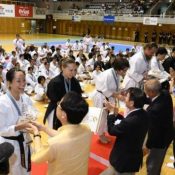
August 6, 2018 Ryukyu Shimpo
The 1st Okinawa International Karate Tournament (hosted by the tournament executive committee, Okinawa Prefecture, and the Okinawa Traditional Karate Promotion Association) selected its first group of champions on the second day of the tournament August 6. The tournament took place at The Okinawa Prefectural Budokan in Naha and the Okinawa Karate Kaikan in Tomigusuku, and welcomed around 1,200 participants from 50 countries or regions who competed in 40 events divided into 5 categories of traditional Karate and Kobudo “kata”.
After the competition, a closing and an award ceremony were held at the Okinawa Prefectural Budokan, where bronze, silver, and gold medals were awarded to the 120 participants who placed in the top 3 of the 40 events in the 5 categories of Shuri/Tomarite, Naha-te, Uechi-ryu, Kobudo Staff, and Kobudo Sai.
After the event, the karate-ka paid their respects to one another, regardless of who was victorious and who was not.
On both August 6 and 7, masters and instructors will be holding seminars, teaching the kata from each of the styles. There are over 2,300 people expected to attend. After the ending of the tournament on August 7, the week-long event will close with a party at the Okinawa Kariyushi Urban Resort Naha starting at 6:30 p.m.
(English translation by T&CT and Sam Grieb)
Go To Japanese
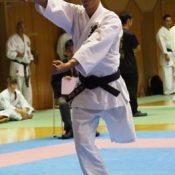
August 3, 2018, Ryukyu Shimpo
“Karate is overcoming adversity.” Jonas Amaral de Fleitas, 25, a karate-ka from the Jyureikan Silva Dojo who lost one of his legs in an accident, performed at the 1st Okinawa Karate International Tournament. Amaral, who performed in the elimination round of the tournament, said with a sense of fulfilment, “If you have passion, anything is possible. This is a dream come true.”
Nine years ago, Amaral was shot twice in his left leg in his hometown. The injury required his left leg to be amputated below the thigh. Feeling hopeless, he kept himself cooped up in his house. Then, in 2011, on the recommendation of a friend, he went to a sports club and was introduced to Brazilian Ju Jitsu. He also tried Tae Kwon Do but, “Karate was the best fit for me.” He soon devoted himself to Karate.
Four times a week, Amaral trained at a dojo in San Paulo, learning to control his body on just one leg. He rapidly improved to the point where he was placing as a finalist in tournaments in South America. This is his first time visiting Okinawa, which, as the birthplace of karate, he says is a “dream.”
In the afternoon of August 2, at the Okinawa Prefectural Budokan in Naha, Amaral’s number was called for the elimination round of the Shuri-te and Tomari-te competition. Placing his crutch down, he hopped up to the competition.
With his gi whipping around, sharp fists cut through the air. The competition finished, and a thunderous applause broke out and continued for some time.
“I did not make it through the preliminary round, but I have no regrets. It is an experience I will never forget. Karate allowed me to get my confidence back. I want to continue improving, and come back to Okinawa,” said Amaral, smiling.
(English translation by T&CT and Sam Grieb)
Go To Japanese
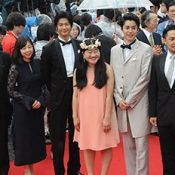
July 29, 2018 Ryukyu Shimpo
On July 27, the Okigin Economic Research Institute announced the results of the preliminary results of the economic ripple effect of the 10th Okinawa International Movie Festival that was held this past April. The employment inducement effect was estimated at 582 people.
The festival reached a milestone since this was the 10th time it was hosted. Due to the research at each venue on number of customers both in and outside of Japan conducted by the Okinawa International Movie Festival’s Executive Committee, the preliminary results were possible.
The total number of sponsors, staff, and customers from in and outside of Japan were a little over 45,000 people. Total expenses including lodging, food, and beverages were 3,792,550,000-yen. Increased demand was 625,980,000-yen due to operating costs, advertising costs, and hosting fees. Preliminary results showed the direct effect of the festival was 4,418,530,000-yen. Employment income inducement effect related to wages was 2,207,530,000-yen.
(English translation by T&CT and Chelsea Ashimine)
Go To Japanese
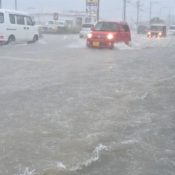
August 2, 2018 Ryukyu Shimpo
On August 1, the Okinawa Meteorological Observatory announced that the regional average precipitation in the Okinawa region in July this year was 3.3 times more than the average year. This was the greatest amount since these statistics started being recorded in 1946, rivaling the rainfalls in 1972. Especially in early July, typhoons approached one after another, 10.5 times more than in the average year. This July, four places in Okinawa achieved a new record monthly rainfall, and all records are from July.
Regional average precipitation was calculated from five places: Naha, Kumejima, Miyakojima, Ishigakijima, and Yonagunijima. In Ishigakijima the precipitation was 536 mm, 411% of the average year, and in Miyakojima precipitation was 517 mm, 395% of the average year.
The Okinawa Meteorological Observatory explained, “There was a strong Pacific anticyclone approaching Honshu. Typhoons, tropical cyclones, and moist air easily flowed into the Okinawa region.” With the influence of Typhoons No. 7 and No. 8 at the beginning of July, the amount of precipitation in Ishigakijima was 17.4 times more than in the average year, and nearly 10 times in Naha. There have been many sunny days since mid-July.
At Shimoji, Kagamihara, and Gusukube in Miyakojima City, and at Nakasuji in Tarama Village, July marked a new record high for precipitation. The anticyclone over the Okinawa region was weak, and the lowest average temperature in July was recorded at Oku in Kunigami Village and Miyagijima in Uruma City. All places received less hours of sunlight compared with the average year.
(English translation by T&CT and Megumi Chibana)
Go To Japanese













 Webcam(Kokusai Street)
Webcam(Kokusai Street)


